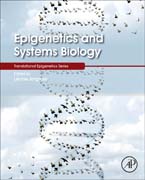
Epigenetics and Systems Biology highlights the need for collaboration between experiments and theoretical modeling that is required for successful application of systems biology in epigenetics studies. This book breaks down the obstacles which exist between systems biology and epigenetics researchers due to information barriers and segmented research, giving real-life examples of successful combinations of systems biology and epigenetics experiments. Each section covers one type of modeling and one set of epigenetic questions on which said models have been successfully applied. In addition, the book highlights how modeling and systems biology relate to studies of RNA, DNA, and genome instability, mechanisms of DNA damage signaling and repair, and the effect of the environment on genome stability. Presents original research in a wider perspective to reveal potential for synergies between the two fields of studyProvides the latest experiments in primary literature for the modeling audienceIncludes chapters written by experts in systems biology and epigenetics who have vast experience studying clinical applications INDICE: Section 1: Introduction Section 2: Where am I? Genomic features and DNA sequence principles defining sites of epigenetic regulation: Machine learning Introduction to section 2 Chapter 1: Computational identification of Polycomb/Trithorax Response Elements Marc Rehmsmeier Chapter 2: Modeling Chromatin States Marc Corrales and Guillaume Filion Chapter 3: Crossing borders: modeling approaches to understand chromatin domains and their boundaries Benjamin L. Moore, Colin A. Semple Chapter 4: Inferring chromatin signaling from genome-wide ChIP-seq data Juliane Perner & Ho-Ryun Chung Section 3. Everything's Moving: In vivo dynamics of epigenetic regulators : Kinetic models based on ordinary differential equations (ODEs) Introduction to section 3 Chapter 5: In vivo biochemistry?: Absolute quantification and kinetic modeling applied to Polycomb and Trithorax regulation Leonie Ringrose Chapter 6: Modeling distributive histone modification by Dot1 methyltransferases: from mechanism to biological insights Dirk De Vos, Hanneke Vlaming, Barbara M. Bakker, Fred van Leeuwen Section 4: Reconciling randomness and precision: Bistable epigenetic memory and switching: Stochastic models Introduction to section 4 Chapter 7: Modeling bistable chromatin states Ian B. Dodd and Kim Sneppen Chapter 8: Quantitative environmentally-triggered switching between stable epigenetic states Rea Antoniou-Kourounioti & Martin Howard Section 5. The third and fourth dimensions: Chromosomal long range interactions : Polymer models Introduction to section 5 Chapter 9: On the nature of chromatin 3D organization: lessons from modelling Mario Nicodemi and Ana Pombo Chapter 10: From chromosome conformation capture to polymer physics and back: Investigating the three-dimensional structure of chromatin within topological associating domains Guido Tiana, Edith Heard, Luca Giorgetti Chapter 11: A combination approach based on live-cell imaging and computational modeling to further our understanding of chromatin, epigenetics, and the genome Kayo Hibino, Kazunari Kaizu, Koichi Takahashi and Kazuhiro Maeshima Chapter 12: Capturing chromosome structural properties from their spatial and temporal fluctuations Aurélien Bancaud, Olivier Gadal, Kerstin Bystricky
- ISBN: 978-0-12-803075-2
- Editorial: Academic Press
- Encuadernacion: Cartoné
- Páginas: 286
- Fecha Publicación: 08/05/2017
- Nº Volúmenes: 1
- Idioma: Inglés
